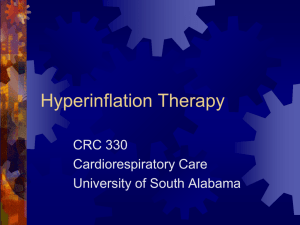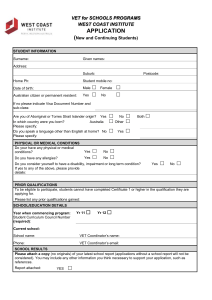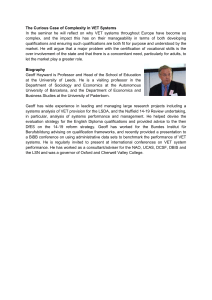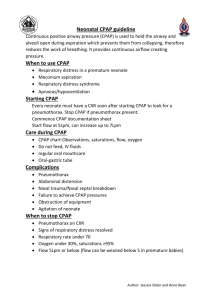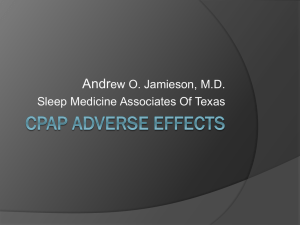Intermittent Positive Pressure Breathing (IPPB)
advertisement
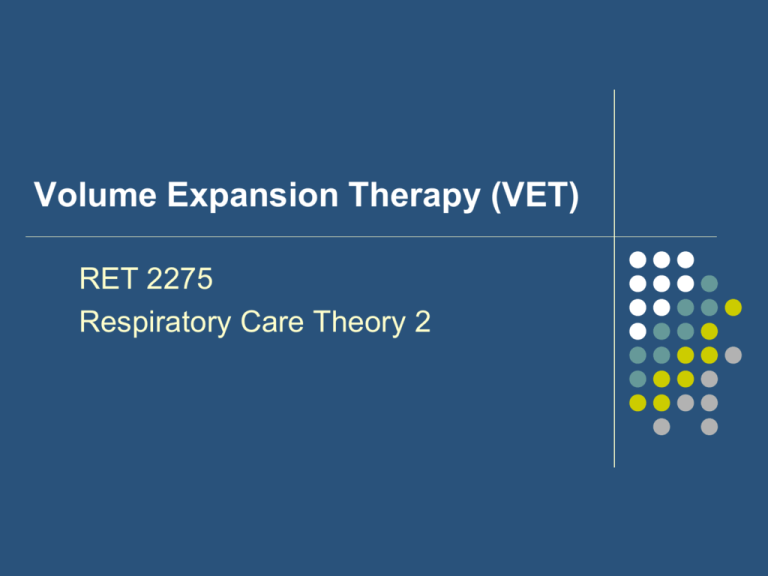
Volume Expansion Therapy (VET) RET 2275 Respiratory Care Theory 2 Volume Expansion Therapy (VET) Volume Expansion Therapy AKA Lung expansion therapy Hyperinflation therapy A variety or respiratory care modalities designed to prevent or correct atelectasis by augmenting lung volumes Incentive Spirometry (IS) Intermittent Positive Airway Pressure (IPPB) Continuous Positive Airway Pressure (CPAP) Positive Expiratory Pressure (PEP) Volume Expansion Therapy (VET) Atelectasis Definition: alveolar collapse Types: Obstructive Caused by mucus plugging of airways Passive Cause by constant tidal breathing of small volumes Common complication in postoperative patients Volume Expansion Therapy (VET) The Sigh Mechanism Definition: the automatic, periodic inhalation of a large tidal volume to prevent passive atelectasis Normally, a person sighs about 6-10 times per hour Passive atelectasis can occur if this mechanism is impaired or lost Volume Expansion Therapy (VET) The Sigh Mechanism Factors that can impair the sigh mechanism General anesthesia Pain Pain medication Decreased level of consciousness Thoracic or upper abdominal surgery Impaired diaphragmatic movement Volume Expansion Therapy (VET) Sustained Maximal Inspiration (SMI) A slow, deep inhalation form the FRC up to (ideally) the total lung capacity, followed by a 5 – 10 second breath hold Designed to mimic natural sighing The negative alveolar & pleural pressures reexpand collapsed alveoli and prevent the collapse of ventilated alveoli Volume Expansion Therapy (VET) Indications Presence of pulmonary atelectasis Presence of condition predisposing to atelectasis Upper abdominal surgery Thoracic surgery Surgery in patient with COPD Presence of a restrictive lung defect associated with quadriplegia and/or dysfunctional diaphragm Volume Expansion Therapy (VET) Contraindications for VET Inability of patient to be instructed to perform SMI maneuver Lack of patient cooperation Inability of patient to deep breathe (i.e. VC <10 ml/kg) Volume Expansion Therapy (VET) Hazards & Complications of VET Ineffective in absence of correct technique (may require repeated instruction & coaching) Hyperventilation Exacerbation of bronchospasm Volume Expansion Therapy (VET) Hazards & Complications of VET Hypoxemia (if O2 therapy is interrupted) Barotrauma (in emphysematous lungs) Fatigue Pain in postoperative patients Volume Expansion Therapy (VET) Assessment of Need Evidence of atelectasis based on physical exam & xray findings Upper abdominal or thoracic surgery Presence of predisposing conditions Presence of neuromuscular disease affecting the respiratory muscles Volume Expansion Therapy (VET) Findings Consistent with Atelectasis Diminished breath sounds & fine crackles in affected area Fever Tachypnea & tachycardia Dull percussion note Characteristic opacity on chest x-ray Volume Expansion Therapy (VET) Incentive Spirometry Equipment Device is only a visual aid Importance is placed on patient performing the correct maneuver Volume Expansion Therapy (VET) Incentive Spirometry (IS) Equipment Volume IS Volume Expansion Therapy (VET) Incentive Spirometry (IS) Equipment Flow oriented (flow x time = volume) Volume Expansion Therapy (VET) Incentive Spirometry (IS) Administering IS Physician order required Instruct patient Importance of deep breathing Demonstration is the most effective way to assist the patient’s understanding and cooperation Position patient Sitting or semi-Fowler’s Semi-Fowler’s Position (Head elevated 30) Volume Expansion Therapy Incentive Spirometry (IS) Administering IS RT should set initial goal (e.g. certain volume) Instruct patient to inspire SLOWLY and deeply Should require some moderate effort Maximizes distribution of ventilation Ensure that the patient is using diaphragmatic breathing Instruct patient to sustain maximal inspiratory volume for 5 – 10 seconds followed by a normal exhalation Volume Expansion Therapy Incentive Spirometry (IS) Administering IS Give the patient an opportunity to rest Some patients need 30 seconds to one minute Helps prevent hyperventilation, dizziness, numbness around the mouth, respiratory alkalosis IS regimen should aim to ensure a minimum of 5 10 SMI maneuvers each hour Once technique is mastered, minimum supervision is required Volume Expansion Therapy (VET) Assessment of Outcome Absence of or improvement in signs of atelectasis Normal respiratory & heart rates Afebrile Absence of abnormal breath sounds Volume Expansion Therapy (VET) Assessment of Outcome Normal chest x-ray Improved oxygenation (PaO2/SpO2) Return of normal spirometric values Improved respiratory muscle performance Volume Expansion Therapy Incentive Spirometry (IS) Charting IS Pre-treatment vital signs Initial goal HR, RR, Breath sounds Example: 800 ml x 10 SMI Patient toleration Post-treatment vital signs Patient education See examples of charting notes on next slide Volume Expansion Therapy (VET) Incentive Spirometry (IS) - Charting Example of Chart Note: 1/31/06, 08:30 IS given to patient sitting in chair. HR = 80 - 72, RR = 16 - 14, Breath sounds decreased at bases bilaterally, some fine crackles noted at end inspiration. Obtained IS goal of 2.0 L x 7 SMI. Patient has a dry, non-productive cough. Breath sounds unchanged after treatment. Patient tolerated treatment without incident. Example of Patient Education Note: Instructed patient regarding the importance taking deep breaths after surgery. Demonstrated IS technique for patient. Patient verbalized understanding of therapy and gave a return demonstration with IS. Sy Big, MDC Student Respiratory Care Volume Expansion Therapy (VET) Important Points Regarding Use of IS Verify that there is an indication for therapy Effective patient teaching & coaching is essential Demonstrate technique for patient Teach splinted coughing Place device within patient’s reach Provide rest periods as necessary CPAP Definition The application of a positive airway pressure to the spontaneously breathing patient throughout the respiratory cycle at pressures of 5 – 20 cm H2O CPAP Physiological Principles CPAP elevates and maintains high alveolar and airway pressures throughout the full breathing cycle. CPAP Physiologic Principles - Equipment The patient on CPAP breaths through a pressurized circuit against a threshold resistor, with pressures maintained between 5 – 20 cm H2O CPAP Physiologic Principles - Equipment CPAP Physiologic Principles CPAP Recruits collapsed alveoli via an increase in FRC CPAP Physiologic Principles CPAP Recruits collapsed alveoli via an increase in FRC Decreases work of breathing due to increased compliance or abolition of auto-PEEP Improves distribution of ventilation through collateral channels (e.g., Kohn’s pores) Increases the efficiency of secretion removal CPAP Indications Postoperative atelectasis Cardiogenic pulmonary edema Refractory hypoxemia PaO2 <60 mm Hg, SaO2 <90% on an FiO2 >0.40 – 0.50 in the presence of adequate ventilatory status (PaCO2 <45 mm Hg, pH 7.35 – 7.45) Obstructive sleep apnea CPAP Contraindications Hemodynamic instability Hypoventilation CPAP does not ensure ventilation Nausea Facial trauma Untreated pneumothorax Elevated intracranial pressure CPAP Hazards and Complications Increased work of breathing caused by the apparatus Patients with ventilatory insufficiency may hypoventilate during application Barotrauma Hypoventilation and hypercapnia More likely in patients with emphysema and blebs Gastric distention (CPAP pressures >15 cm H2O) Vomiting and aspiration in patients with an inadequate gag reflex CPAP Monitoring and Troubleshooting Patients must be able to maintain adequate excretion of CO2 on their own System pressure must be monitored Alarms need to indicate system disconnect or mechanical failure Masks may cause irritation and pain Adequate flow to meet patient’s need Flow initially set to 2 – 3 times the patients minute ventilation Flow is adequate when the system pressure drops no more than 1 – 2 cm H2O during inspiration CPAP Patient Interfaces Nasal Mask CPAP Patient Interfaces Fitting the Nasal Mask Dorsum of nasal bridge Around the nasal alae Mid philtrum Use foam bridge Prevents collapse of mask onto nose CPAP Patient Interfaces Fitting the Nasal Mask DO NOT over tighten Tissue necrosis CPAP – Tissue necrosis CPAP Patient Interfaces Full-Face Mask CPAP Patient Interfaces Fitting the Full-Face Mask Dorum of nasal bridge Surrounds nose/mouth Rests below lower lip DO NOT over tighten Tissue necrosis Foam bridge Prevents collapse of mask onto nose CPAP Nasal vs. Full-Face Mask Nasal Masks More prone to air leaks (especially mouth breathers) Use chin strap Full-Face Mask Increase dead space Risk of aspiration Claustrophobia Interferes with expectoration of secretions, communication, eating CPAP Patient Interfaces Total Face Mask EZ-PAP Lung expansion therapy during inspiration and PEP therapy during exhalation Used for the treatment or prevention of atelectasis and the mobilization of secretions Aerosol drug therapy may be added to a PEP session to improve the efficacy of bronchodilator EZ-PAP EZ-PAP EZ-PAP EZ-PAP with SVN IPPB Definition The application of inspiratory positive pressure to a spontaneously breathing patient as an intermittent or short-term therapeutic modality IPPB Definition The delivery of a slow deep sustained inspiration by a mechanical device providing controlled positive pressure breath during inspiration IPPB Indications (AARC) The need to improve lung expansion Treatment of atelectasis not responsive to other therapies, (e.g., IS and CPT) Inability to clear secretions adequately Limited ventilation Ineffective cough IPPB Indications (AARC) Short-term nonivasive ventilatory support for hypercapnic patients Alternative to intubation and continuous ventilatory support IPPB Indications (AARC) The need to deliver aerosol medication When MDI or nebulizer has been unsuccessful Patients with ventilatory muscle weakness or fatigue IPPB Contraindications (AARC) Tension pneumothorax ________________________________________ ICP > 15 mm Hg Hemodynamic instability Recent facial, oral or skull surgery IPPB Contraindications (AARC) Tracheoesophageal fistula Recent esophageal surgery Active hemoptysis Nausea Air swallowing IPPB Contraindications (AARC) Active, untreated TB Radiographic evidence of bleb Singulus (hiccups) IPPB Hazards (AARC) Increase airway resistance (Raw) Barotrauma, pneumothorax Nosocomial infection Hyperventilation (hypocapnia) Hemoptysis IPPB Hazards (AARC) Hyperoxia when O2 is the gas source Gastric distention Secretion impaction (inadequate humidity) Psychological dependence Impedance of venous return IPPB Hazards (AARC) Exacerbation of hypoxemia Hypoventilation Increased V/Q mismatch Air trapping, auto peep, overdistended alveoli IPPB Potential Outcomes Improved IC or VC Increased FEV1 or peak flow Enhanced cough or secretion clearance Improved Chest radiograph Improved breath sounds IPPB Potential Outcomes Improved oxygenation Favorable patient subjective response IPPB Baseline Assessment Vital signs Patient’s appearance and sensorium Breathing pattern Breath sounds IPPB Implementation Infection control Equipment preparation Pressure check machine/circuit Patient orientation Why MD ordered therapy What treatment does How it feels Expected results IPPB Implementation Application Mouthpiece / nose clip (initially) Mouthseal Mask Trach adaptor IPPB Implementation Machine settings Sensitivity of 1 – 2 cm H2O Initial pressure between 10 – 15 cm H20 Breathing pattern of 6 breaths/min I:E ration of 1:3 to 1:4 Flow and pressure will need subsequent adjustment to patient’s needs and goal IPPB Implementation When treating atelectasis Therapy should be volume-oriented Tidal volumes (VT) must be measured VT goals must be set VT goal of 10 – 15 mL/kg of body weight Pressure can be increased to reach VT goal if tolerated by patient IPPB Implementation When treating atelectasis IPPB is only useful in the treatment of atelectasis if the volumes delivered exceeds those volumes achieved by the patient’s spontaneous efforts IPPB Discontinuation and Follow-Up Treatments typically last 15-20 minutes Repeat patient assessment Identify untoward effects Evaluate progress Document

